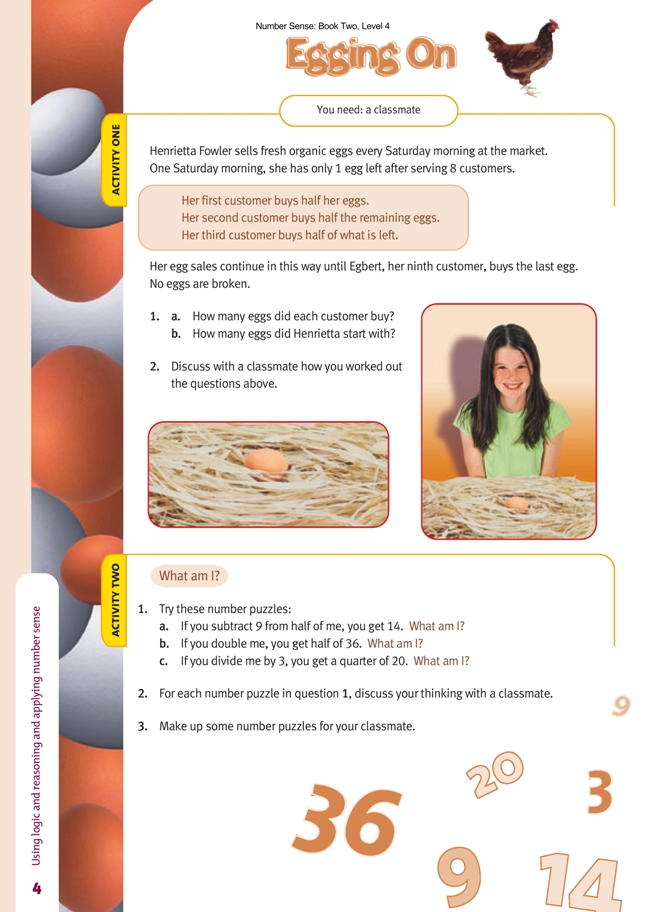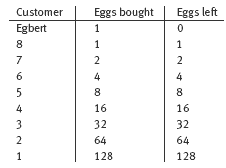This is a level 4 number activity from the Figure It Out series. It relates to Stage 7 of the Number Framework.
A PDF of the student activity is included.
Click on the image to enlarge it. Click again to close. Download PDF (614 KB)
apply logic and number sense to solve problems
A classmate
Activity One
There are various ways that the students might go about solving the problems in question 1. Perhaps the simplest way is to use a calculator. Firstly, though, the students will need to realise that the scenario involves continuous halving (that is, each customer except for the last one buys half of the available eggs), so getting
back to the original number of eggs will require continuous doubling. If there was one egg left for the ninth customer, there must have been two eggs left when the eighth customer arrived at the market stall. A calculator is an excellent tool here. By systematically pushing x 2 = , it is possible to determine the number of eggs that were there when each customer arrived. Then it is just a matter of recording these on a chart, for example:
This shows that Henrietta began with 256 eggs.
The strategy of doubling may suggest to the students that this activity has something to do with powers of 2, and indeed it has. It is possible to work out the number of eggs Henrietta started with, and how many each customer bought, by setting out a table with powers of 2 as below.
This shows that the total number of eggs that Henrietta began with was 28, which is 256. This can be calculated by going, for example, 28, = 23 x 23 x 22 (that is, 8 x 8 x 4) or 28 = 24, x 24, (that is, 16 x 16). Notice that the exponents of 23 x 23 x 22 add up to 8 and that in general, 2a x 2b = 2(a+b). Notice too that in terms of powers
of 2, 20 means 1 and 21 means 2. The number of eggs each customer bought can be calculated mentally in a similar way. Alternatively, the students may choose to construct a number line to display the required information. Here again, scale is not critical as long as the relationships are clear.
Activity Two
The problems in Activity Two also require the students to work backwards from the known to the unknown number, although some students may try other strategies that they can explain to the class. Thus, in question 1a, the known number is 14, and this has resulted from 9 being subtracted from a number. The first step is therefore to add 9 to 14. This gives 23. Now, this 23 represents half of the original number, so if 23 is doubled, the original number of 46 is obtained. The students who have a feeling for algebra may be able to use the following kind of strategy: 14 = (n ÷ 2) – 9, which in turn can be written as 14 + 9 = n ÷ 2, which can finally be written as 23 x 2 = n.
Similar strategies can be used for questions 1b and 1c. Working backwards, question 1b has 36 as the known number, but this is twice the amount of another number, namely, 18. Since the 18 is double the number of the original we are looking for, it is now just a matter of halving 18 to give 9 as the solution. Likewise, in question 1c, the known number is 20, but the number being sought has something to do with one-quarter of 20, which is 5. The 5 is the result of dividing a number by 3, so the original number can be found by multiplying 5 by 3. Following this logic, it must be 15.
Answers to Activity
Activity One
1. a. You could work backwards as follows:
b. Henrietta started with 256 eggs.
2. Solutions will vary. You could use the strategy shown above. Keep doubling until you reach the first customer. For b, you could add all the purchases together, or better still, double the first purchase.
Activity Two
1. a. 46
b. 9
c. 15
2. Strategies will vary. Possible thinking could be:
a. 14 + 9 = 23. 2 x 23 = 46
b. Half of 36 is 18. 18 ÷ 2 = 9
c. 1/4 of 20 is 5. ÷ 3 = 5. = 15




